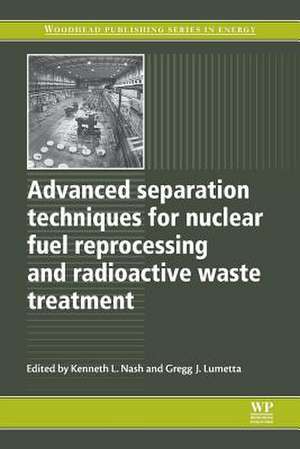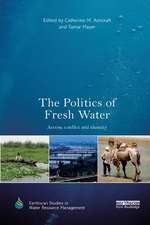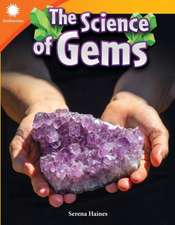Advanced Separation Techniques for Nuclear Fuel Reprocessing and Radioactive Waste Treatment: Woodhead Publishing Series in Energy
Editat de Kenneth L Nash, Gregg J Lumettaen Limba Engleză Paperback – 18 aug 2016
Advanced separation techniques for nuclear fuel reprocessing and radioactive waste treatment provides a comprehensive and timely reference on nuclear fuel reprocessing and radioactive waste treatment. Part one covers the fundamental chemistry, engineering and safety of radioactive materials separations processes in the nuclear fuel cycle, including coverage of advanced aqueous separations engineering, as well as on-line monitoring for process control and safeguards technology. Part two critically reviews the development and application of separation and extraction processes for nuclear fuel reprocessing and radioactive waste treatment. The section includes discussions of advanced PUREX processes, the UREX+ concept, fission product separations, and combined systems for simultaneous radionuclide extraction. Part three details emerging and innovative treatment techniques, initially reviewing pyrochemical processes and engineering, highly selective compounds for solvent extraction, and developments in partitioning and transmutation processes that aim to close the nuclear fuel cycle. The book concludes with other advanced techniques such as solid phase extraction, supercritical fluid and ionic liquid extraction, and biological treatment processes.
With its distinguished international team of contributors, Advanced separation techniques for nuclear fuel reprocessing and radioactive waste treatment is a standard reference for all nuclear waste management and nuclear safety professionals, radiochemists, academics and researchers in this field.
- A comprehensive and timely reference on nuclear fuel reprocessing and radioactive waste treatment
- Details emerging and innovative treatment techniques, reviewing pyrochemical processes and engineering, as well as highly selective compounds for solvent extraction
- Discusses the development and application of separation and extraction processes for nuclear fuel reprocessing and radioactive waste treatment
Din seria Woodhead Publishing Series in Energy
-
 Preț: 853.22 lei
Preț: 853.22 lei - 24%
 Preț: 1209.19 lei
Preț: 1209.19 lei - 24%
 Preț: 1307.96 lei
Preț: 1307.96 lei - 24%
 Preț: 1386.95 lei
Preț: 1386.95 lei - 9%
 Preț: 900.25 lei
Preț: 900.25 lei - 9%
 Preț: 1067.83 lei
Preț: 1067.83 lei - 29%
 Preț: 1071.46 lei
Preț: 1071.46 lei - 9%
 Preț: 950.40 lei
Preț: 950.40 lei - 9%
 Preț: 1011.50 lei
Preț: 1011.50 lei - 29%
 Preț: 1071.13 lei
Preț: 1071.13 lei - 9%
 Preț: 1309.35 lei
Preț: 1309.35 lei - 39%
 Preț: 1047.65 lei
Preț: 1047.65 lei - 9%
 Preț: 949.23 lei
Preț: 949.23 lei - 24%
 Preț: 1688.64 lei
Preț: 1688.64 lei - 9%
 Preț: 1344.70 lei
Preț: 1344.70 lei - 9%
 Preț: 1049.56 lei
Preț: 1049.56 lei - 27%
 Preț: 1937.44 lei
Preț: 1937.44 lei - 23%
 Preț: 1519.01 lei
Preț: 1519.01 lei - 23%
 Preț: 1074.68 lei
Preț: 1074.68 lei - 29%
 Preț: 981.24 lei
Preț: 981.24 lei - 9%
 Preț: 1397.24 lei
Preț: 1397.24 lei - 39%
 Preț: 1397.48 lei
Preț: 1397.48 lei - 9%
 Preț: 945.89 lei
Preț: 945.89 lei - 9%
 Preț: 1073.87 lei
Preț: 1073.87 lei - 9%
 Preț: 1514.09 lei
Preț: 1514.09 lei - 9%
 Preț: 1020.23 lei
Preț: 1020.23 lei - 39%
 Preț: 880.81 lei
Preț: 880.81 lei - 9%
 Preț: 950.94 lei
Preț: 950.94 lei - 39%
 Preț: 1225.96 lei
Preț: 1225.96 lei - 9%
 Preț: 1214.08 lei
Preț: 1214.08 lei - 9%
 Preț: 868.43 lei
Preț: 868.43 lei - 24%
 Preț: 1615.93 lei
Preț: 1615.93 lei - 31%
 Preț: 927.68 lei
Preț: 927.68 lei - 24%
 Preț: 1077.86 lei
Preț: 1077.86 lei - 9%
 Preț: 946.04 lei
Preț: 946.04 lei - 9%
 Preț: 952.05 lei
Preț: 952.05 lei - 9%
 Preț: 1165.33 lei
Preț: 1165.33 lei - 24%
 Preț: 1307.96 lei
Preț: 1307.96 lei - 29%
 Preț: 1213.47 lei
Preț: 1213.47 lei - 24%
 Preț: 1075.25 lei
Preț: 1075.25 lei - 24%
 Preț: 1048.44 lei
Preț: 1048.44 lei - 29%
 Preț: 1454.22 lei
Preț: 1454.22 lei - 39%
 Preț: 1285.27 lei
Preț: 1285.27 lei - 9%
 Preț: 952.68 lei
Preț: 952.68 lei - 23%
 Preț: 878.04 lei
Preț: 878.04 lei - 9%
 Preț: 951.98 lei
Preț: 951.98 lei - 9%
 Preț: 1209.42 lei
Preț: 1209.42 lei - 9%
 Preț: 1233.82 lei
Preț: 1233.82 lei
Preț: 1085.98 lei
Preț vechi: 1774.16 lei
-39% Nou
Puncte Express: 1629
Preț estimativ în valută:
207.80€ • 217.54$ • 171.94£
207.80€ • 217.54$ • 171.94£
Carte tipărită la comandă
Livrare economică 31 martie-14 aprilie
Preluare comenzi: 021 569.72.76
Specificații
ISBN-13: 9780081017234
ISBN-10: 0081017235
Pagini: 512
Dimensiuni: 156 x 234 x 26 mm
Greutate: 0.71 kg
Editura: ELSEVIER SCIENCE
Seria Woodhead Publishing Series in Energy
ISBN-10: 0081017235
Pagini: 512
Dimensiuni: 156 x 234 x 26 mm
Greutate: 0.71 kg
Editura: ELSEVIER SCIENCE
Seria Woodhead Publishing Series in Energy
Cuprins
Contributor contact details
Woodhead Publishing Series in Energy
Preface
Part I: Fundamentals of radioactive materials separations processes: chemistry, engineering and safeguards
Chapter 1: Chemistry of radioactive materials in the nuclear fuel cycle
Abstract:
1.1 Introduction
1.2 Chemical features of important fission products and actinides
1.3 Relevant actinide chemistry in the nuclear fuel cycle
1.4 Essential features of solvent extraction separations in the nuclear fuel cycle
1.5 Behavior in molten salts/molten metals/ionic liquids/alternative media
1.6 Interactions at interfaces significant to the nuclear fuel cycle
1.7 Future trends
Chapter 2: Physical and chemical properties of actinides in nuclear fuel reprocessing
Abstract:
2.1 Introduction
2.2 Thermodynamic properties of compounds
2.3 Speciation, complexation and reactivity in solution of actinides
2.4 Irradiation effects
2.5 Future trends
2.6 Sources of further information and advice
Chapter 3: Chemical engineering for advanced aqueous radioactive materials separations
Abstract:
3.1 Introduction
3.2 Containment concepts
3.3 Separations equipment
3.4 Equipment materials considerations
3.5 Future trends
3.6 Sources of further information and advice
Chapter 4: Spectroscopic on-line monitoring for process control and safeguarding of radiochemical streams in nuclear fuel reprocessing facilities
Abstract:
4.1 Introduction
4.2 Static spectroscopic measurements
4.3 Demonstration of spectroscopic methods
4.4 Conclusions
4.5 Acknowledgments
4.7 Appendix: acronyms
Chapter 5: Safeguards technology for radioactive materials processing and nuclear fuel reprocessing facilities
Abstract:
5.1 Introduction
5.2 Requirements
5.3 Safeguards technology
5.4 Safeguards applications for aqueous separations
5.5 Safeguards applications for pyrochemical separations
5.6 Acknowledgement
Part II: Separation and extraction processes for nuclear fuel reprocessing and radioactive waste treatment
Chapter 6: Standard and advanced separation: PUREX processes for nuclear fuel reprocessing
Abstract:
6.1 Introduction
6.2 Process chemistry
6.3 Current industrial application of PUREX
6.4 Future industrial uses of PUREX
6.5 Conclusions
Chapter 7: Alternative separation and extraction: UREX+ processes for actinide and targeted fission product recovery
Abstract:
7.1 Introduction
7.2 Separation strategy
7.3 UREX + LWR SNF GNEP application: separation strategy
7.4 Benefits of using models to design flowsheets
7.5 Advantages and disadvantages of techniques
7.6 Future trends
Chapter 8: Advanced reprocessing for fission product separation and extraction
Abstract:
8.1 Introduction
8.2 Separation methods, advantages/disadvantages, and future trends
8.3 Conclusions and future trends
Chapter 9: Combined processes for high level radioactive waste separations: UNEX and other extraction processes
Abstract:
9.1 Introduction to universal extraction process (UNEX) and other processes
9.2 Universal processes for recovery of long-lived radionuclides
9.3 Development and testing of the universal extraction (UNEX) process and its modifications
9.4 Conclusions
Part III: Emerging and innovative techniques in nuclear fuel reprocessing and radioactive waste treatment
Chapter 10: Nuclear engineering for pyrochemical treatment of spent nuclear fuels
Abstract:
10.1 Introduction
10.2 Process chemistry and flowsheet of pyrochemical processing
10.3 Design and installation of process equipment
10.4 Materials behaviour and interactions
10.5 Developments in monitoring and control for pyrochemical processing
10.6 Techniques for safe and effective interoperation of equipment
10.7 Future trends
10.8 Sources of further information and advice
Chapter 11: Development of highly selective compounds for solvent extraction processes: partitioning and transmutation of long-lived radionuclides from spent nuclear fuels
Abstract:
11.1 Introduction
11.2 Which long-lived radionuclides to partition and why?
11.3 How to develop selective ligands and extractants?
11.4 Examples of development of highly selective compounds in European partitioning and transmutation (P&T) strategy
11.5 Future trends
11.6 Conclusions
11.7 Sources of further information and advice
11.8 Acknowledgment
Chapter 12: Developments in the partitioning and transmutation of radioactive waste
Abstract:
12.1 Introduction to transmutation
12.2 Modelling transmutation processes and effects
12.3 Systems for transmutation: design and safety
12.4 Transmutation fuel development
12.5 Future trends
Chapter 13: Solid-phase extraction technology for actinide and lanthanide separations in nuclear fuel reprocessing
Abstract:
13.1 Introduction
13.2 Basic methodology of solid-phase extraction
13.3 Solid-phase extraction sorbents for actinides and lanthnides
13.4 Modeling of solid-phase extraction systems
13.5 Advantages and disadvantages of solid-phase extraction in treatment processes for nuclear fuel reprocessing streams
13.6 Future trends in solid-phase extraction technology for nuclear fuel reprocessing applications
13.7 Sources of further information and advice
13.8 Acknowledgment
Chapter 14: Emerging separation techniques: supercritical fluid and ionic liquid extraction techniques for nuclear fuel reprocessing and radioactive waste treatment
Abstract:
14.1 Introduction
14.2 Supercritical fluid extraction of lanthanides and actinides
14.3 Direct dissolution of uranium oxides in supercritical carbon dioxide
14.4 Current industrial demonstrations of supercritical fluid extraction technology for nuclear waste treatment and for reprocessing spent fuel
14.5 Ionic liquid and supercritical fluid coupled extraction of lanthanides and actinides
14.6 Future trends
Chapter 15: Development of biological treatment processes for the separation and recovery of radioactive wastes
Abstract:
15.1 Introduction
15.2 Classification of waste
15.3 Waste from high temperature fast reactors
15.4 Treatment options
15.5 Biological removal of metal oxyions
15.6 Biosorption and recovery
15.7 Biofilm processes
15.8 Future trends
15.11 Engineering dimensions (units)
Index
Woodhead Publishing Series in Energy
Preface
Part I: Fundamentals of radioactive materials separations processes: chemistry, engineering and safeguards
Chapter 1: Chemistry of radioactive materials in the nuclear fuel cycle
Abstract:
1.1 Introduction
1.2 Chemical features of important fission products and actinides
1.3 Relevant actinide chemistry in the nuclear fuel cycle
1.4 Essential features of solvent extraction separations in the nuclear fuel cycle
1.5 Behavior in molten salts/molten metals/ionic liquids/alternative media
1.6 Interactions at interfaces significant to the nuclear fuel cycle
1.7 Future trends
Chapter 2: Physical and chemical properties of actinides in nuclear fuel reprocessing
Abstract:
2.1 Introduction
2.2 Thermodynamic properties of compounds
2.3 Speciation, complexation and reactivity in solution of actinides
2.4 Irradiation effects
2.5 Future trends
2.6 Sources of further information and advice
Chapter 3: Chemical engineering for advanced aqueous radioactive materials separations
Abstract:
3.1 Introduction
3.2 Containment concepts
3.3 Separations equipment
3.4 Equipment materials considerations
3.5 Future trends
3.6 Sources of further information and advice
Chapter 4: Spectroscopic on-line monitoring for process control and safeguarding of radiochemical streams in nuclear fuel reprocessing facilities
Abstract:
4.1 Introduction
4.2 Static spectroscopic measurements
4.3 Demonstration of spectroscopic methods
4.4 Conclusions
4.5 Acknowledgments
4.7 Appendix: acronyms
Chapter 5: Safeguards technology for radioactive materials processing and nuclear fuel reprocessing facilities
Abstract:
5.1 Introduction
5.2 Requirements
5.3 Safeguards technology
5.4 Safeguards applications for aqueous separations
5.5 Safeguards applications for pyrochemical separations
5.6 Acknowledgement
Part II: Separation and extraction processes for nuclear fuel reprocessing and radioactive waste treatment
Chapter 6: Standard and advanced separation: PUREX processes for nuclear fuel reprocessing
Abstract:
6.1 Introduction
6.2 Process chemistry
6.3 Current industrial application of PUREX
6.4 Future industrial uses of PUREX
6.5 Conclusions
Chapter 7: Alternative separation and extraction: UREX+ processes for actinide and targeted fission product recovery
Abstract:
7.1 Introduction
7.2 Separation strategy
7.3 UREX + LWR SNF GNEP application: separation strategy
7.4 Benefits of using models to design flowsheets
7.5 Advantages and disadvantages of techniques
7.6 Future trends
Chapter 8: Advanced reprocessing for fission product separation and extraction
Abstract:
8.1 Introduction
8.2 Separation methods, advantages/disadvantages, and future trends
8.3 Conclusions and future trends
Chapter 9: Combined processes for high level radioactive waste separations: UNEX and other extraction processes
Abstract:
9.1 Introduction to universal extraction process (UNEX) and other processes
9.2 Universal processes for recovery of long-lived radionuclides
9.3 Development and testing of the universal extraction (UNEX) process and its modifications
9.4 Conclusions
Part III: Emerging and innovative techniques in nuclear fuel reprocessing and radioactive waste treatment
Chapter 10: Nuclear engineering for pyrochemical treatment of spent nuclear fuels
Abstract:
10.1 Introduction
10.2 Process chemistry and flowsheet of pyrochemical processing
10.3 Design and installation of process equipment
10.4 Materials behaviour and interactions
10.5 Developments in monitoring and control for pyrochemical processing
10.6 Techniques for safe and effective interoperation of equipment
10.7 Future trends
10.8 Sources of further information and advice
Chapter 11: Development of highly selective compounds for solvent extraction processes: partitioning and transmutation of long-lived radionuclides from spent nuclear fuels
Abstract:
11.1 Introduction
11.2 Which long-lived radionuclides to partition and why?
11.3 How to develop selective ligands and extractants?
11.4 Examples of development of highly selective compounds in European partitioning and transmutation (P&T) strategy
11.5 Future trends
11.6 Conclusions
11.7 Sources of further information and advice
11.8 Acknowledgment
Chapter 12: Developments in the partitioning and transmutation of radioactive waste
Abstract:
12.1 Introduction to transmutation
12.2 Modelling transmutation processes and effects
12.3 Systems for transmutation: design and safety
12.4 Transmutation fuel development
12.5 Future trends
Chapter 13: Solid-phase extraction technology for actinide and lanthanide separations in nuclear fuel reprocessing
Abstract:
13.1 Introduction
13.2 Basic methodology of solid-phase extraction
13.3 Solid-phase extraction sorbents for actinides and lanthnides
13.4 Modeling of solid-phase extraction systems
13.5 Advantages and disadvantages of solid-phase extraction in treatment processes for nuclear fuel reprocessing streams
13.6 Future trends in solid-phase extraction technology for nuclear fuel reprocessing applications
13.7 Sources of further information and advice
13.8 Acknowledgment
Chapter 14: Emerging separation techniques: supercritical fluid and ionic liquid extraction techniques for nuclear fuel reprocessing and radioactive waste treatment
Abstract:
14.1 Introduction
14.2 Supercritical fluid extraction of lanthanides and actinides
14.3 Direct dissolution of uranium oxides in supercritical carbon dioxide
14.4 Current industrial demonstrations of supercritical fluid extraction technology for nuclear waste treatment and for reprocessing spent fuel
14.5 Ionic liquid and supercritical fluid coupled extraction of lanthanides and actinides
14.6 Future trends
Chapter 15: Development of biological treatment processes for the separation and recovery of radioactive wastes
Abstract:
15.1 Introduction
15.2 Classification of waste
15.3 Waste from high temperature fast reactors
15.4 Treatment options
15.5 Biological removal of metal oxyions
15.6 Biosorption and recovery
15.7 Biofilm processes
15.8 Future trends
15.11 Engineering dimensions (units)
Index





















